Holiday Titles Round-Up, Part Three: Do Olivia, Osbert, Otto, and the others deliver?
 December 6th, 2007 by jules
December 6th, 2007 by jules

by Janet Morgan Stoeke
Penguin Young Readers Group
September 2007
(library copy)
Minerva Louise has many fans, and I don’t think they’ll be disappointed with this new title, all about Minerva’s confusion on Christmas Eve. To be sure, it’s not anything new and still the same formula: Minerva is slightly feather-brained, and the child reader gets to be in the know, in on the joke, one step ahead of the protagonist. But it works every time, due to Minerva’s unassuming charm. And Stoeke writes with a clarity and conciseness that is perfect for the preschool-aged crowd — and even for beginning readers (Stoeke makes it easy to put those beginning inferencing skills to work). “If ever a chicken was meant to enjoy Christmas Eve, it’s the eternally upbeat, perpetually ingenuous Minerva Louise,” wrote the Horn Book review (which you can read in its entirety here). Beginning the book with Minerva’s perspective from outside the house (“Minerva Louise loved the way the snow sparkled on the house with the red curtains”), she works her way closer to the home and ends up inside. And all along the way, she’s baffled and bewildered, as is usually the case: She thinks the lights on the trees outside are fireflies, “all dressed up in party colors!”; she sees reindeer on the roof and thinks they’re goats; and she thinks the angel atop the tree is a “pretty white hen” who’s “been laying the most beautiful eggs! They are all over the branches.” The illustrations are simple shapes with simple details, outlined in black, and this time there’s a bit more of a kick in color, what with the Christmas reds and greens goin’ on. The final illustration makes for big laughs from the preschool crowd (and this adult, too): Minerva gets a present from Santa (“the farmer in the red hat”) and promptly throws it aside after opening it to sit in the warm tissue paper inside the packaging with a joyful smile only Minerva can give. Funny stuff. Long live Minerva.

by Lisa Wheeler
Illustrated by Ivan Bates
Harcourt
October 2007
(review copy)
It truly is hard to come across outstanding holiday titles, but I really like this one. There are only so many situations Santa can get himself into, only so much trouble that can be concocted for him, to make the conflict for a new Christmas title. Usually, it’s a play on A Visit from St. Nicholas, more commonly called The Night Before Christmas, which can get old. But Wheeler keeps things uncluttered for the youngest reader in this title; in the simple plot, Santa simply fell into the snow, snowshoes sticking up, though the child doesn’t discover this ’til the end. Each spread before that is dedicated to a different forest animal and his unique tromp through the snow — with Wheeler’s rhythmic, rolls-right-off-your-tongue text. After establishing on the sprawling opening spread with reindeer that Santa cannot be found, the rabbit (“Hip-hop, hip-hop, polar paws. Where, oh where, is Santa Claus?”) and then the seal-pup twins (“Flip-flop, flip-flop, polar two. Santa! Santa! Where are you?”) and then the fox (“Pit-pat, pit-pat, polar paws. Where, oh where, is Santa Claus?”) and so on aid in the search. And it’s all expertly propelled forward with Bates’ soft, very rounded crayon-and-watercolor illustrations (think lots of pink — but not too nauseatingly sweet); there’s lot of energy and action — and Bates uses both boundless spreads and panels — as each animal leaps forward, prompting page turns for your preschooler (even toddler) listener, as she eagerly anticipates where Santa can be found and if those animals can help out. It’s a comforting, winsome Christmas story for your wee listener I’d easily add to my holiday title collection.

by Harry Horse
Peachtree Publishers
September 2007
(library copy)
The publisher will tell you this is a “gently reassuring story” in which Little Rabbit “quickly learns the value of friendship.” And, sure, it is. And it’s Little Rabbit, a character I find endearing and even rather irresistible, created by an author/illustrator with talent. Harry Horse’s detailed, soft watercolors, his cozy creations of Little Rabbit and his home are places I like to visit. The dramatic cautionary tale that is Little Rabbit Lost (2002) shows us an author/illustrator at work who knows how to tap into the emotional worlds of young children. Do you feel like there’s a “but . . .” coming? Well, there is. Sort of. And, to be clear, I think this is one of the well-done new Christmas titles out there. Here’s what happens in this story: On Christmas Eve, Little Rabbit sees a wonderful red sled in a shop window. This is now ALL he wants for Christmas. Can’t get his mind off of it. Makes sure his parents know that is what he wants. The Christmas Bunny pulls through, and the red sled is waiting for Little Rabbit on Christmas morning. He goes to show his friends. When each friend wants a turn on the sled, Little Rabbit goes off to sled by himself. But a steep hill and a frozen stream cause problems for Little Rabbit, and his friends — though previously scorned by Little Rabbit — show up to help. It’s a good story. Harry Horse — in these Little Rabbit tales — is good at bringing to life the complicated emotions of childhood friendships. But here’s my “but . . .”, my minor complaint. There is no question that Little Rabbit shouldn’t have pushed his friends in an effort to keep them away from his brand-spankin’-new toy (which oh yes, snap-snap, he does at one point); the story goes off in that direction, and, sure, children need to learn to share, not to mention it’s rather touching when his spurned friends deliver for him in the end. But there is a part of me that thought, hey, it’s his kickin’ new sled. In the name of self-preservation, paws off, pals! He doesn’t need to be hateful about it, but there is something to that notion. I’m just sayin’.
Minor, hardly-brilliant point on my part. Just hardly ever gets covered in picture books. Those grabby kids. Bah humbug.

by Beth Terrill
Illustrated by Greg Newbold
Random House
October 2007
(review copy)
Santa’s reindeer have eaten too much sweet Christmas pudding (Good for them. Restricting oneself’s at such a delectable time of year is nonsense in my book), and they can’t fly Santa, who has landed in a barnyard, the rest of the way home. The barnyard animals have been bickering. No one’s getting along, and poor little Pip, the barnyard mouse, just wants some peace. After continuing to bicker over whether or not they can fly Santa’s sleigh, Pip pipes up, announcing he’s found some balloons and some rope. “With balloons round each belly in red, green, and blue/ The animals started to float, two by two.” Alack, they nip and kick and squabble some more, bouncing the world’s presents out of Santa’s sleigh down toward the ground. The brave pig dives down for the toys, only to find that his rope has snapped. Down he falls to the ground; yet, he’s saved by the others in an elaborate rescue attempt. Santa makes it in the end, and everyone’s learned a bit about cooperation . . . It’s not as heavy-handed as it sounds, and Terrill’s rhyming couplets are well-constructed with a pleasing rhythm, never too forced. Newbold nails the bickering with the wide array of dramatic facial expressions given to the barnyard animals, and each one looks as if it can be plucked right off the brightly-colored pages. You can see Pip featured on Newbold’s ’07 snowflake at this Blogging for a Cure feature at The Longstockings’ site. Publishers Weekly, noting that this is one of those recastings of the aforementioned Clement C. Moore poem, writes, “this outing substitutes silliness for Moore’s sense of wonder.”
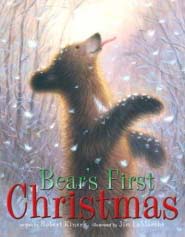

by Robert Kinerk
Illustrated by Jim LaMarche
Simon & Schuster
October 2007
(library copy)
Speaking of rhyming couplets, here’s another picture book with some. Lots of them, as it’s a rather wordy text, which tells the story of a small bear, hibernating in the woods, who awakens to hear a mysterious sound from afar. Following the source of the noise, he makes friends on his way with various animals in the woods, often aiding them in their search for food in the snow. As a group, they make it to a house in the woods, all aglow from inside at night with a celebration of Christmas, complete with a brightly-lit tree. It’s a sweet, sing-songy read about how the animals are touched by the warmth they witness in this family and how afterwards they carry it in their hearts with them (yes, you’ll get the the-true-meaning-of-Christmas-is-discovered phrase from the publisher and such, which is fine; I just admit to being a bit jaded on that phrase’s overuse at this time of year). I love LaMarche’s illustrations, and these are soft, gentle, glittering illustrations (acrylic and colored pencil) of winter in the woods. He can talk to me through his art work about “the true meaning of Christmas” any ‘ol day. Yowsers. There are some beautiful spreads here, and the very young bear is quite endearing. And, since the whole animals-sharing-in-the-snow motif brings to mind George Shannon and Laura Dronzek’s beautiful ’07 title, Rabbit’s Gift (Harcourt), I’ll remind you that I already reviewed it (at ForeWord Magazine, but you can get to it from here). I said it then and I’ll say it again: If you treat yourself to any one snowy, winter-time book this year, let it be this sparkly gem of a book, an adaptation of a centuries-old Chinese folktale.
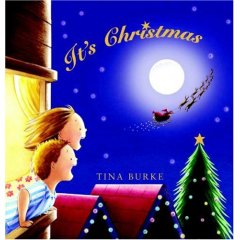
by Tina Burke
Kane/Miller
September 2007
(review copy)
You will not ever read or hear me describe a children’s book as “cute.” Call me a snob if you must. And I have friends who are children’s lit aficionados and/or have studied it extensively who have used this adjective to describe a children’s book. It’s not necessarily a wrong thing to do, and I know I sound insufferably, you-probably-wanna-smack me pretentious. But there’s this way that some people have of condescending to children’s lit, as if children don’t deserve anything beyond “cute.” And, yes, those people like to dismiss a brilliant, clever title as simply “oh, it’s just so cute.” And that’s that. So, I just refuse to ever do it. My children’s lit prof in grad school forbade us from using it in class to describe a book (god love ‘er). Well, Tina Burke challenges me. Her illustrations verge on cu . . . Oh, I just can’t say it. They are adorable. How’s that? But in a good way. Her work is more than just adorable. It’s decidedly simple — her neat, rounded illustrations with limited detail and nothing extraneous. Nothing that gets in the way of the very youngest reader’s/listener’s ability to comprehend a simple story about — in this case — Christmas. In fact, it’s not even a story. It’s a glimpse into Christmas traditions and the joy they can bring for the youngest child: baking sugar cookies (mmm); visiting Santa; singing carols; and making a hat for your mother’s gift when you only have fifty cents and all the hats are over one hundred smackaroos each. It’s like an alternate Charlie Brown universe — there are never adults around (except she makes an exception for Santa in this title); the children are in charge; and their curiosities and wonderings rule the day. Burke could easily slip into Precious Moments land, but fortunately she knows when to hit the brakes. Publishers Weekly put it best (with Burke’s fabulous wordless title from last year, Fly, Little Bird), calling out its “eloquent simplicity.” Or, as Magpies Magazine from Australia put it, “her illustrative style with its rhythmical lines, energetic body language and bright colours is fresh and original.”
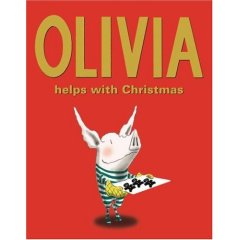
by Ian Falconer
Atheneum
October 2007
(library copy)
When I put out my request for aid in my holiday-book-review-round-up challenge, one blogger — also jaded on the commercialism of the Christmas season — responded to me with, do we really need a bloated Olivia Christmas picture book? Even if you you’re an Olivia fan, you know it’s a valid question. I suppose there have even been Olivia detractors since her debut, claiming she’s an Eloise copycat anyway. But what I say that Falconer did and still does well, even with each more plot-tenuous Olivia title (Publishers Weekly described this one as “{m}ore a succession of family anecdotes-in-the-making than a plot-driven story”), is tune in to the thought processes of children (or, as the School Library Journal review of Olivia Forms a Band put it, “{w}ith perfectly nuanced dialogue and a mixture of comical and artful scenes, Falconer explores the logic, invention, and humor emanating from a talented youngster, serious about the mission of the moment”). It might get old to some folks, but I also say, hey, there’s some really bad children’s lit out there. Let’s pick our battles — not to mention, hey, we knew this was bound to happen (in fact, I have a vague memory of reading before that Falconer set out for one of the previous Olivia titles to be a holiday one, but fate had a different plan). And it’s hardly as if we’re settling here anyway: It may not be his best book ever, but it’s funny, particularly Olivia’s fervent holiday caroling. And Falconer captures well the frenzied joys of the Christmas season for wee children, including the anticipation of snow and playing in it (“Although interestingly agnostic on the subject of Santa, Olivia’s latest disaster-prone caper otherwise wholeheartedly indulges in every {secular} Christmas motif: snow to be wished for, a tree to be decorated, lights to be untangled, stockings, presents, more presents, sledding — and even a dream-Nutcracker starring you-know-who,” wrote the Horn Book review, which you can read in its entirety here). Bottom line is that Falconer’s work, I contend, remains a visual gift and a fascinating study in how an author/illustrator can “play pictures and text off each other to maximum comic impact” (Publishers Weekly). {BONUS: Go here to see a video of Falconer talking about Olivia; he’s nothing like I imagined him to be, but that’s neither here nor there}.
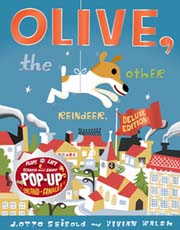
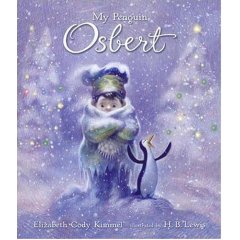 These are not new ’07 titles, but they have been released in new editions. First, Chronicle Books has released the deluxe edition of Olive, the Other Reindeer by Vivian Walsh and J. Otto Seibold, which marks the book’s tenth anniversary. What’s “deluxe” about it? you may wonder. There are flaps to lift and scratch-and-sniff moments (and I think this edition is larger than the original, but don’t quote me on that). These added elements are a) not much to write home about and b) don’t make the book stand out from the original too terribly much, but there is a totally fun, eye-popping pop-up of a grand finale on the final spread (Santa’s home in the North Pole), complete with lift-able roofs and detailed rooms inside, etc. . . . Secondly, Candlewick has released an ’07 edition of My Penguin Osbert, originally published in 2004, by Elizabeth Cody Kimmel and illustrated by H.B. Lewis. I like this story, the dramatic be-careful-what-you-ask-for cautionary tale that it is. And the illustration of the boy hugging Osbert goodbye . . . DAMN! It gets me every. time. What’s new about this edition, you wonder? It comes with a plush toy, if that kind of thing blows your hair back. If not, Osbert fans can still be happy the book remains in print in this day and age of quickly-disappearing titles.
These are not new ’07 titles, but they have been released in new editions. First, Chronicle Books has released the deluxe edition of Olive, the Other Reindeer by Vivian Walsh and J. Otto Seibold, which marks the book’s tenth anniversary. What’s “deluxe” about it? you may wonder. There are flaps to lift and scratch-and-sniff moments (and I think this edition is larger than the original, but don’t quote me on that). These added elements are a) not much to write home about and b) don’t make the book stand out from the original too terribly much, but there is a totally fun, eye-popping pop-up of a grand finale on the final spread (Santa’s home in the North Pole), complete with lift-able roofs and detailed rooms inside, etc. . . . Secondly, Candlewick has released an ’07 edition of My Penguin Osbert, originally published in 2004, by Elizabeth Cody Kimmel and illustrated by H.B. Lewis. I like this story, the dramatic be-careful-what-you-ask-for cautionary tale that it is. And the illustration of the boy hugging Osbert goodbye . . . DAMN! It gets me every. time. What’s new about this edition, you wonder? It comes with a plush toy, if that kind of thing blows your hair back. If not, Osbert fans can still be happy the book remains in print in this day and age of quickly-disappearing titles.
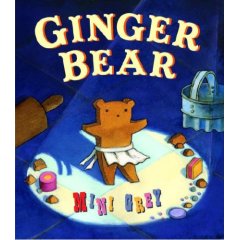 Let’s not forget, though it never set out to be a holiday title, Mini Grey’s Ginger Bear (Random House), released this year, and which I reviewed here at the end of June.
Let’s not forget, though it never set out to be a holiday title, Mini Grey’s Ginger Bear (Random House), released this year, and which I reviewed here at the end of June.
For all the gingerbread goodness, all the cookie-making, and Ginger Bear’s final snowy destination in the pastry shop during the winter, complete with her skis and warm scarf and all the icing around (Mmm. Icing), I say it works as a good snow-time read. Or any time read, due to the wonderfully weird mind and active imagination of the one and only Mini Grey.

I liked the Osbert gift set – the plush guy is super-cute. Thanks for reminding me about Ginger Bear!
I’ve said it before, and I’ll say it again. I LOVE MINERVA LOUISE! She is just my favorite chicken ever. Why isn’t there a plush Minerva Louise doll gift set? How cute would that be?
Huh. I had someone come into our store looking for most of these titles yesterday. I guess someone locally is a faithful 7 Imp reader.
The problem I have with Olivia‘s size is that it begs for more patience than the average lapsitter will give it. I tend to think of Olivia as more of an adult title because time and again I see parents attempt to interest their young ones in the book and quickly their attention flies elsewhere. All the adult reviewers can say what they want, Olivia is the one character only adults ask for… and the same goes for Eloise
[…] loves loves Ms. Minerva Louise. And then I reviewed the wonderful Minerva Louise on Christmas Eve (here) at the beginning of this month and thought, hey, maybe Janet Morgan Stoeke would be willing to […]
[…] of year, there’s always Bear’s First Christmas by Robert Kinerk, which I posted about here in 2007, but I […]